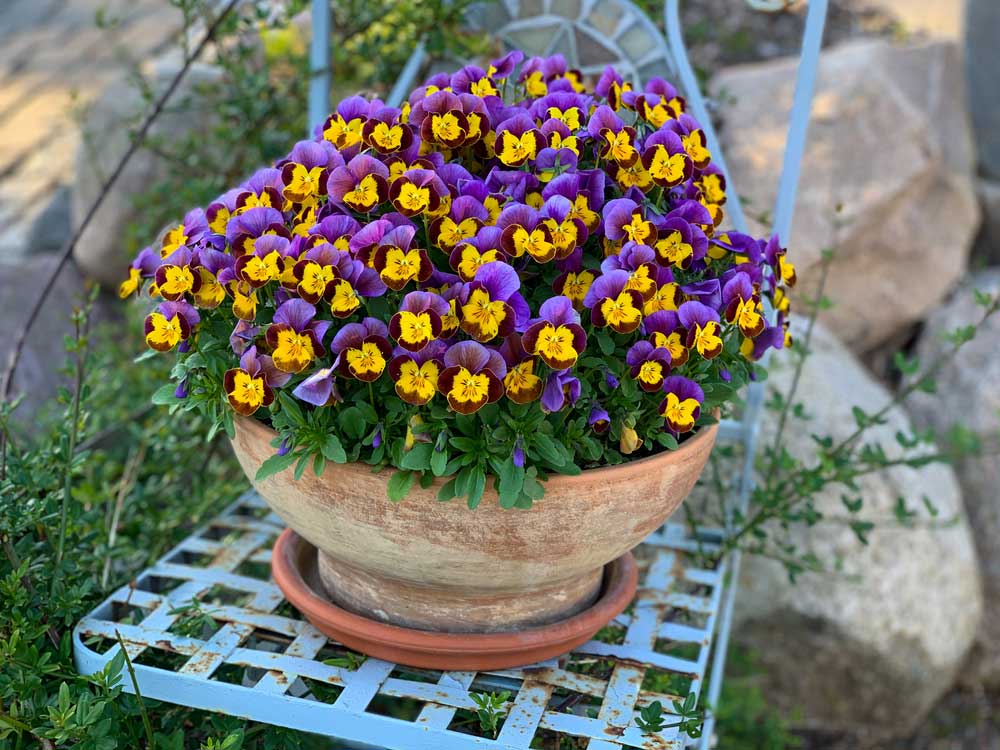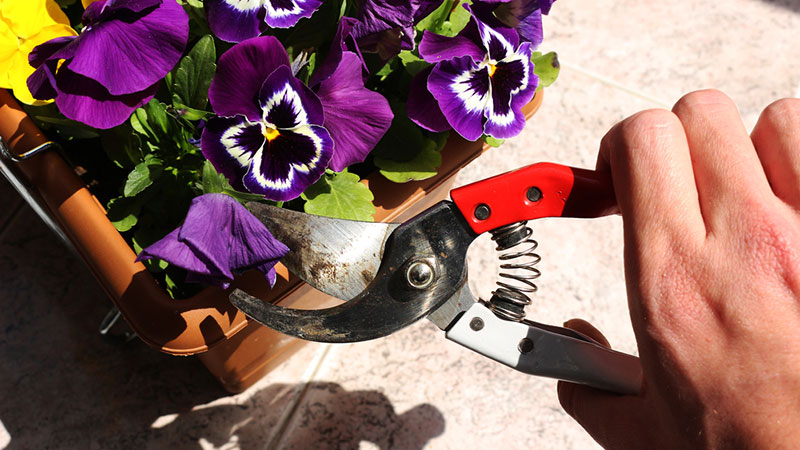With their heart-shaped petals and vibrant colors, pansies are great flowers for adding color and beauty to your space.

Not only do they spread joy and aroma all around, but they’re also edible and have dermatological purposes. Additionally, pansies are easy to grow and are available in wide varieties.
If you want to brighten your home with these versatile flowers, here are 12 tips for growing pansies in pots or containers.
1. Choose When to Plant Your Pansies
Pansies thrive in cool weather when temperatures are mild. So, it’s better to plant them in midsummer or fall, as this is when they’ll blossom the most.
Pansies don’t tolerate humidity either. The flowers will likely fade during hot summers and bloom again in the winter.
Ideally, you could start planting your pansies in September or October. This way, the flowers will have the chance to bloom throughout the winter till spring.

2. Provide Adequate Sunlight
Where you place your pansies is important and a bit tricky. On one hand, Pansies are known for their ability to grow in cooler temperatures. On the other hand, they still require enough sunlight to grow. So, the correct placement of your pansies is critical for their growth.
In other words, the placement of your pansies will depend on where you live and the season of the year. Additionally, pansies need around six hours of sunlight daily.
As such, if you live in a cold area, put your pansies’ containers in a place where they can receive plenty of sunlight during the day. If you live in a region with hot summers, it’s best to place your pansies in partial shade.
More importantly, the flowers will need to receive shade during the hottest parts of the day.
Keep in mind that too much direct sunlight can cause your pansies to wilt. So, you’ll have to be watchful of weather conditions and sunny areas.
3. Use Well-Draining Pots
Pansies are delicate flowers and require soil that drains well to grow. They’re prone to root rotting and other plant diseases which are caused by overly wet soil. Therefore, the pots or containers of pansies must have a good drainage system for the water to escape.

To plant your pansies in a draining pot, first, fill it with potting soil mixed with compost. Create a hole in the center of the soil and carefully place the pansy inside it. The plant shouldn’t be too deep or too shallow; its roots should be covered in soil but not buried in it.
After planting, water the plant thoroughly until water drains from the bottom of the pot. Finally, place your pot in a place with good sunlight.
Make sure that the bottom of the pot isn’t blocked, as the water will accumulate beneath it; preferably, place your pot on a drainage shelf that allows excess water to drain.
4. Water Regularly but Not Excessively
Like most plants, pansy plants require regular watering and hydration to blossom. However, watering must be done carefully as pansies don’t endure soggy soil. The key is to keep the soil moist but not overly wet.
Water daily, yet check the soil beforehand to see whether it still needs watering. In case the soil is still wet, leave it for a while. If the soil is slightly dry, water the pansies.
If you live in a cold region, it’s better to water your pansies in the morning to allow them to dry.
However, when the weather is hot, it’s better to water the pansies when the temperatures are cooler, so the water doesn’t quickly evaporate.
5. Fertilize Frequently
Pansies require a nurturing and healthy environment to grow. Here are a few tips to follow when fertilizing your pansies:
- Use a slow-release fertilizer every month when the pansies are still growing
- Use a liquid fertilizer every two or three weeks during the growing season
- Water the soil thoroughly before fertilizing to prevent root burn
- Apply fertilizer evenly around the base of each plant, and water thoroughly afterward
- Follow the directions on the fertilizer package for usage and storing
6. Deadhead Pansies Regularly

Deadheading Pansies is essential to promote their growth and keep them looking good. It’s the process of removing the spent blooms to encourage flower production and minimize pests and flower diseases.
To deadhead your pansy flower; pinch the stem at the point you want to cut off with your thumb and forefinger. Use your other hand to hold the stem in place, then rip off the top part. Cut as close to the stem as possible, so you don’t cut any additional parts.
You can also use scissors for deadheading. However, most people prefer to use their fingers for accuracy.
After you deadhead the pansies, they’ll bloom rather quickly. So, make sure you repeat the exercise every few days.
7. Avoid Overcrowding the Container
Overcrowding the pot or container of your pansies could stunt their growth and reduce their blooms. Moreover, overcrowded containers could lead to competition for water and nutrients between the plants.
Pansies also require good air circulation to grow healthy. Overcrowding could lead to fungal diseases in flowers, which leads to drooping, and eventually, death.
To ensure your pansies have enough space, choose a big enough container for the number of flowers you’re planting. A good rule of thumb is to leave six to ten inches between each plant.
8. Mulch Your Pansies to Retain Moisture

Mulching the pansies helps retain moisture in the soil and protects them from extreme weather conditions.
Choose a mulch with organic materials, such as pine bark, because it breaks down over time, improving the quality of the soil. Apply a thin layer of mulch around each plant, making sure not to cover its base.
Before mulching, clean the area around your pansies by removing weeds or debris that may have accumulated.
9. Give Them Time to Mature Indoors
When you’re growing your pansies from seed, you should start the process indoors, 10-12 weeks before the last frost date. Make sure you sow the seeds at least 6 inches apart.
Pansies require darkness to germinate, so leave them indoors until the seeds sprout.
Once they’ve sprouted, transplant them to the drainage pot to a place with sunlight and keep the soil moist.
10. Protect Your Pansies From Insects
Pansies are prone to insect infestations which could damage or kill them. It’s important to keep your pots or containers clean, as insects thrive in dirty environments.
Use neem oil because it’s a natural insect repellent and won’t harm your plants. Add a small amount of neem oil to water in a spray bottle and regularly spray the plants with it. This will keep away unwanted insects from your pansies.
11. Use a Soil Mix
Pansies prefer soil rich in organic matter and a slightly acidic pH level. The ideal pH level for pansies is between 5.5 and 6.5.
When buying potting soil, it’s recommended to look for a mix that contains peat, moss, compost, and vermiculite. These materials provide drainage while retaining moisture and nutrients.
12. The Right Humidity Level
Pansies don’t tolerate high humidity, but they still need to receive a proper amount of it to flourish. Humidity for pansies should ideally be between 40%-60%.
During hot weather, ensure that your pansies are watered properly and regularly to avoid dehydration.
You could also acidify water to raise its pH balance and then spray it on the leaves.
Conclusion
In conclusion, keeping these tips in mind while growing your pansies will help you create vibrant flowers to fill your home.
You don’t have to be an expert gardener to plant pansies in pots and containers. Just be mindful of the soil, water, and sunlight your pansies need. Make sure you choose the right container size and leave enough room for your pansies to grow too.
Planting and caring for your pansies can be a rewarding experience, and you’ll quickly come to enjoy the results of your work.




 ?. ts.dhung.
?. ts.dhung.
